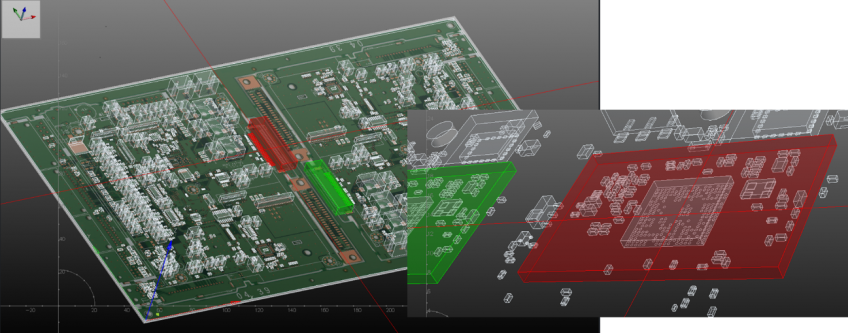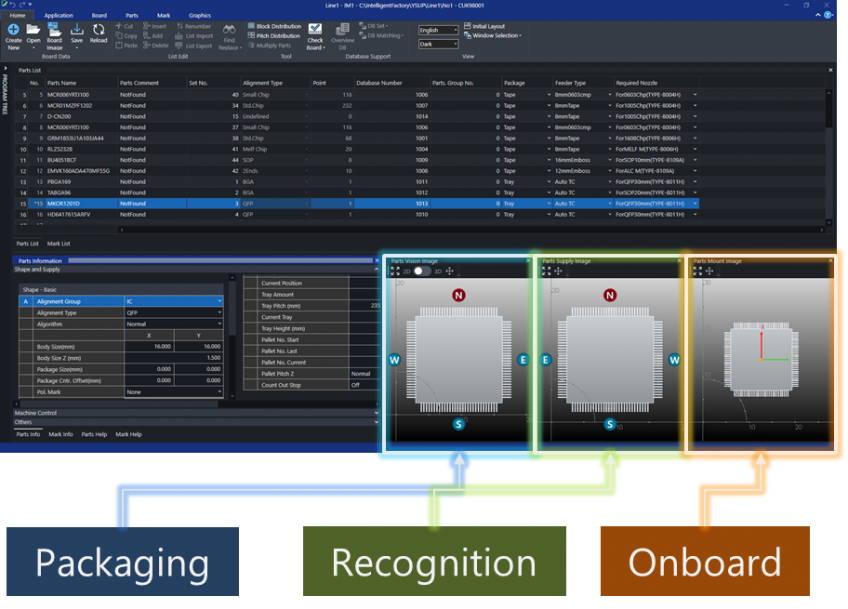The drive to optimize SMT production has been accompanied by equipment development since its inception. Successive generations operate at ever-increasing speeds, shorter downtimes and, consequently, ever-increasing productivity. However, the sphere of software for these lines and the time it takes to develop it is also not without significance.
Reducing programming problems
Conventional methods of program development require a great deal of work and a great deal of ingenuity on the part of the programmers implementing them. This is because they often involve gathering the necessary information from different sources – such as CAD/CAM data, Gerber data, bill of materials (BOM) or tile images – as well as reconciling this differently formatted and vendor-sourced information.
As software becomes more powerful with each successive generation, however, more and more of these problems can be eliminated by automating them. As a result, production can begin more quickly, and the line can start producing finished boards almost immediately, saving time spent building test boards that are conventionally used to help tune the assembly program.

To this end, YAMAHA has brought together tools to automate programming tasks – particularly those that are the most labor- and time-intensive. Combining them into a single platform, called YsUP (Yamaha’s Unique and Proven solutions), allows access to all programming-related applications. YsUP uses the latest machine software standards and is being introduced with the new generation of YAMAHA YRM20 automatic machines. The system includes applications that collect information about the materials used, including tools for monitoring, process setup, traceablity, as well as setup verification, component counting, MSD and LED BIN code management. The use of easy-to-use and highly automated development tools has resulted in a unified tool for centralized data and component flow management, allowing users to easily switch between applications.
In addition, with the 3D preview of the boards and components, users can visualize the assembly ( Figure 1) – how all the components should be installed, their coordinates and angular data.
Data editing and conversion
Using the application in YsUP, production teams can speed up program development and improve production quality by creating the necessary data and verifying the correct assembly of components before producing any packages. Real-time visualization allows users to create component data in relation to an image ( Figure 2), which greatly simplifies the task and helps avoid errors.
Working at an earlier stage than traditional virtual tape analysis, the desktop test assembly uses gerber and CAM data to verify that parts will be correctly aligned to their corresponding landings ( Figure 3). Detecting errors at this point allows necessary corrections to be applied before any boards are produced, resulting in higher quality and production efficiency.

Automatic conversion tools enable users to start producing packages in a short time. Standard CAM data in a format such as ODB++, GenCAD or FABmaster data provides essential information such as assembly coordinates, component information and board image. In this case, the assembly program is created easily using the standard CAM converter. The CAM converter also supports functions such as panelization of the board and is able to generate a visualization of the layout on the board. Finally, the program is automatically optimized to configure lines and check whether parts and nozzles collide. Templates make it easier to set up the feeder.

Completing missing data
In the past, programming has often been hampered by the lack of adequate data on the package being created. It can be as simple as the CAM and BOM data not being available in the right format for the CAM converter. Files may express data such as assembly angles or component coordinates in a way that is not supported. YsUP includes tools, converting text data to a format suitable for program generation.
Gerber image tool
Checking issues such as mounting coordinates, polarity and component angles in advance can significantly speed up setup. With YsUP Gerber Image Tool, users can quickly generate high-quality PCB images from gerber data. When both the PCB image and gerber data are available, the tool allows easy comparison to point out any discrepancies that could lead to component placement problems in production (Figure 4).
Moreover, the acquired gerber data can also be used to generate AOI data, allowing users to start generating inspection programs without needing to wait for physical boards to be made available.

Scanner tool
On the other hand, there are cases when the gerber data needed to create a tile image is not available. YsUP helps users create a high-quality board image by scanning the board and scaling the image correctly. The board image can then be combined with the converted assembly program using the editor. In extreme cases, there may be no data about the original PCB at all. To solve such situations, the YsUP scanner tool allows users to scan the actual PCB and automatically create all the required data. In other cases, only a component list printout may be available. In such cases, YsUP’s image editor can help create the program by dragging and dropping components onto the PCB image. After the user manually places the components in the appropriate locations, the tool aligns them. This is done by using the automatic learning function.
Automatic learning and polarity checking
Automatic learning compares the board image with the corresponding CAD coordinates and component library definitions, so that all components are correctly aligned with respect to patterns, including pin-1 and polarity markers. Automatic learning automatically corrects up to 1,000 components per minute for any offsets that may be due to incorrect or incomplete data. This can happen, for example, if the CAM data describes the center of the component and its mounting angle data in a way that is different from the standard. This can prevent the machine from mounting the part on the board in the correct position and angle. Auto-teach corrects the errors and shows the collection of incorrect angle data. It also includes a tracking function that helps verify corrections without having to visually inspect all parts on the board.
Parts Library Wizard
The wizard assists the programmer in situations where components do not exist in the standard library. The wizard guides the user step by step by asking for the parameters needed to recognize the component, such as the number of leads, lead size, pitch, component center position and others. It is also possible to add new components to the library using a scanned and dimensionally verified image.
BOM variation
An additional Skip-Variation feature in YsUP helps users support multiple product variations based on the same base board. This is often used in the automotive industry, where different options are offered using the same board to maintain production speed. The assembly variant import tool compares multiple part lists and generates a variant list, which is used to automatically create an assembly program for each BOM. The program uses a common feeder layout to produce all variants, further simplifying production operations.
Conclusions
Each successive generation of high-speed SMT assembly equipment brings important innovations to improve assembly speed, increase flexibility and minimize human involvement. High-performance software tools, which combine management and programming applications with automated functions and the added convenience of 3D graphics, simplify programming, improve the quality of the programs created, and thus impact overall productivity.


EXCLUSIVE DISTRIBUTOR OF YAMAHA SMT and YAMAHA Robotics – RENEX GROUP
The exclusive distributor of YAMAHA SMT and YAMAHA Robotics in Poland as well as Central and Eastern European countries is RENEX Group. YAMAHA equipment, as well as other products from the RENEX product range, can be seen and tested in action under production line test conditions, including on the company’s own components and subassemblies, at the RENEX TECHNOLOGY CENTER and DEMOROOM. In addition to equipment, RENEX Group provides a comprehensive range of consulting and advisory services in the field of production process automation. If you are interested, please contact the RENEX Group’s Technical and Commercial Advisors.
